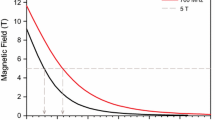Abstract
Magic-angle spinning (MAS) is mandatory in solid-state NMR experiments to achieve resolved spectra. In rare cases, instabilities in the rotation or damage of either the rotor or the rotor cap can lead to a so called “rotor crash” involving a disintegration of the sample container and possibly the release of an aerosol or of dust. We present a modified design of a 3.2 mm probe with a confining chamber which in case of a rotor crash prevents the release of aerosols and possibly hazardous materials. 1D and 2D NMR experiments show that such a hazardous material-confining MAS probe (“CONFINE-MAS” probe) has a similar sensitivity compared to a standard probe and performs equally well in terms of spinning stability. We illustrate the CONFINE-MAS probe properties and performance by application to a fungal amyloid.






Similar content being viewed by others
References
Andrew ER, Bradbury A, Eades RG (1958) Nuclear magnetic resonance spectra from a crystal rotated at high speed. Nature 182:1659–1659
Baldus M, Petkova AT, Herzfeld J, Griffin RG (1998) Cross polarization in the tilted frame: assignment and spectral simplification in heteronuclear spin systems. Mol Phys 95:1197–1207
Böckmann A et al (2009) Characterization of different water pools in solid-state NMR protein samples. J Biomol NMR 45:319–327
Böckmann A, Ernst M, Meier BH (2015) Spinning proteins, the faster, the better? J Magn Reson 253:71–79
Bousset L, Brundin P, Böckmann A, Meier B, Melki R (2015) An efficient procedure for removal and inactivation of alpha-synuclein assemblies from laboratory materials. J Parkinson’s Dis 6:143–151
First MW (1998) HEPA filters. J Am Biol Saf Assoc 3:33–42
Fogh R et al (2002) The CCPN project: an interim report on a data model for the NMR community. Nat Struct Mol Biol 9:416–418
Gor’kov PL et al (2007) Low-E probe for 19F–1H NMR of dilute biological solids. J Magn Reson 189:182–189
Lowe IJ (1959) Free induction decays of rotating solids. Phys Rev Lett 2:285–287
Schütz AK et al (2015) Atomic-resolution three-dimensional structure of amyloid β fibrils bearing the Osaka mutation. Angew Chem Int Ed 54:331–335
Stevens T et al (2011) A software framework for analysing solid-state MAS NMR data. J Biomol NMR 51:437–447
Takegoshi K, Nakamura S, Terao T (1999) 13C–13C polarization transfer by resonant interference recoupling under magic-angle spinning in solid-state NMR. Chem Phys Lett 307:295–302
Takegoshi K, Nakamura S, Terao T (2001) 13C–1H dipolar-assisted rotational resonance in magic-angle spinning NMR. Chem Phys Lett 344:631–637
Tuttle MD et al (2016) Solid-state NMR structure of a pathogenic fibril of full-length human α-synuclein. Nat Struct Mol Biol 23:409
Van Melckebeke H et al (2010) Atomic-resolution three-dimensional structure of HET-s (218–289) amyloid fibrils by solid-state NMR spectroscopy. J Am Chem Soc 132:13765–13775
Vranken WF et al (2005) The CCPN data model for NMR spectroscopy: development of a software pipeline. Proteins 59:687–696
Wälti MA et al (2016) Atomic-resolution structure of a disease-relevant Aβ(1–42) amyloid fibril. Proc Natl Acad Sci USA 113:E4976–E4984
Wasmer C et al (2008) Amyloid fibrils of the HET-s (218–289) prion form a β solenoid with a triangular hydrophobic core. Science 319:1523–1526
Acknowledgements
This work was supported by the Swiss National Science Foundation (Grant 200020_159707), by the French ANR (ANR-11-LABX-0048 through ANR-11-IDEX-0007), and the ETH Career SEED-69 16-1. This project has received funding from the European Research Council (ERC) under the European Union’s Horizon 2020 research and innovation programme (Grant agreement no. 741863, FASTER).
Author information
Authors and Affiliations
Corresponding authors
Electronic supplementary material
Below is the link to the electronic supplementary material.
Rights and permissions
About this article
Cite this article
Wiegand, T., Hunkeler, A., Däpp, A. et al. CONFINE-MAS: a magic-angle spinning NMR probe that confines the sample in case of a rotor explosion. J Biomol NMR 72, 171–177 (2018). https://doi.org/10.1007/s10858-018-0218-x
Received:
Accepted:
Published:
Issue Date:
DOI: https://doi.org/10.1007/s10858-018-0218-x



